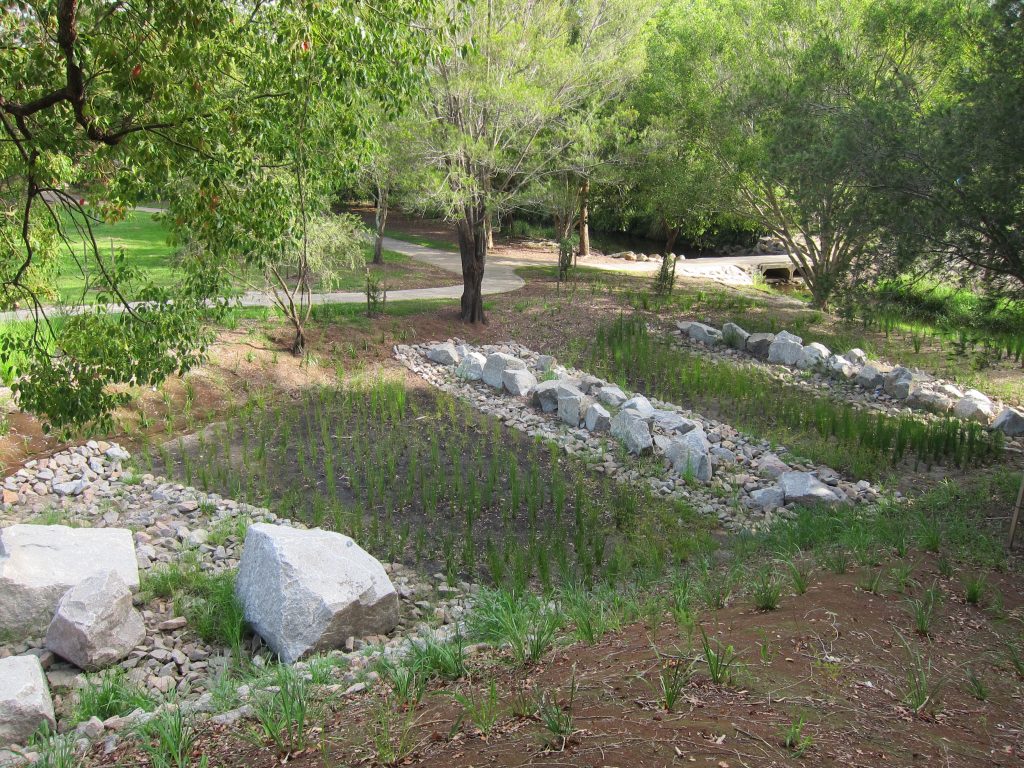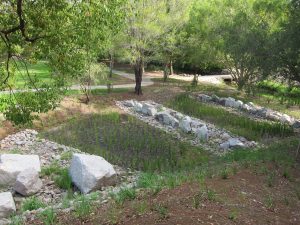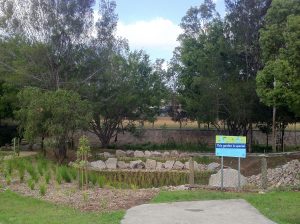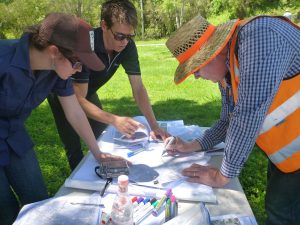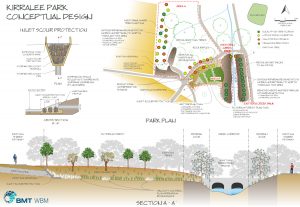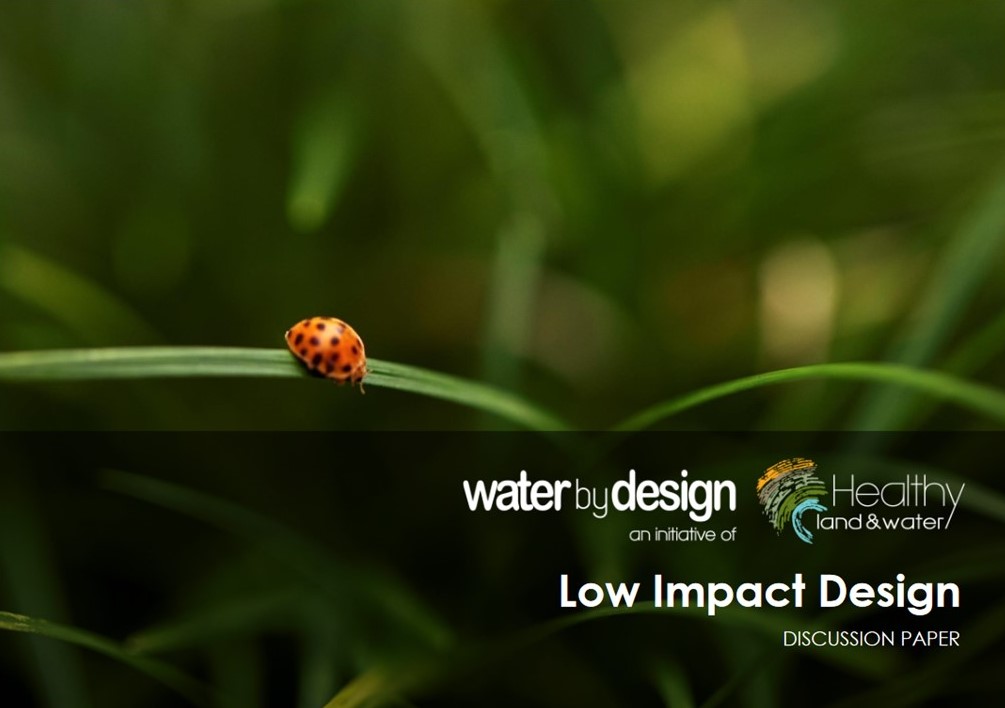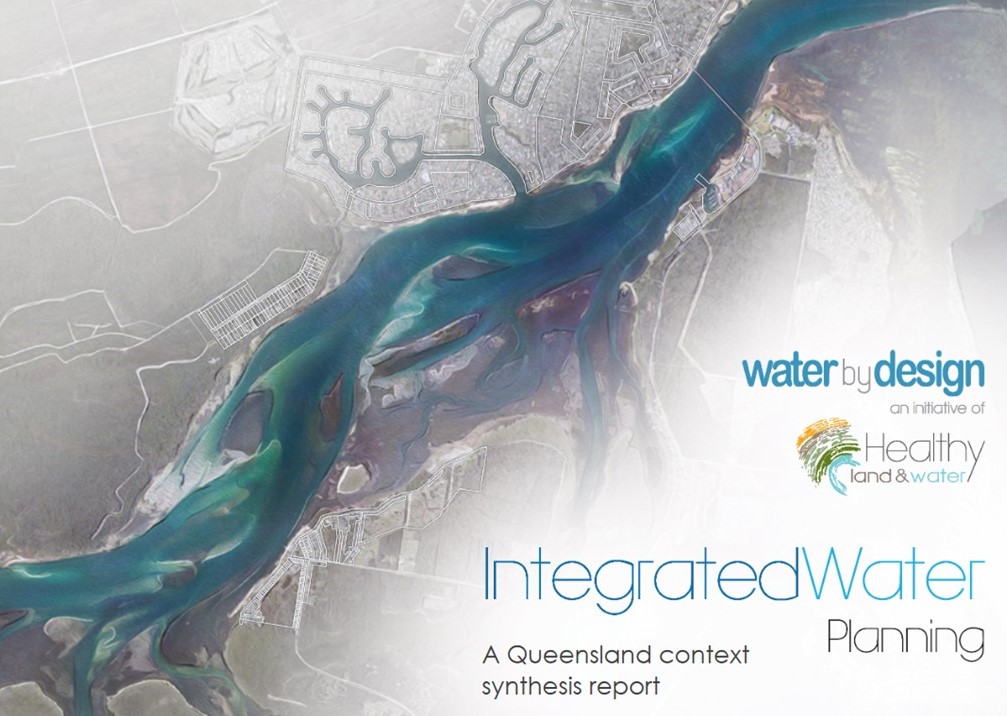Project Description
The ‘Creek Filtration Systems’ Trial is a Lord Mayor’s deliverable under the ‘Cleaner Waterways Initiative’. It is a four-year trial of a range of filtration systems aimed to enhance waterway health in four of Brisbane’s major catchments. The creek filtration trial at Kirralee Park is one of eight systems being trialled in these catchments.
The Kirralee Park creek filtration trial works by slowing down and filtering polluted stormwater from an urban catchment before it discharges to a tributary of Kedron Brook. Stormwater which flows from the nearby roads, footpaths and residential allotments, is collected by existing pit and pipe network before discharging into two separate areas including the filtration system and an adjacent existing vegetated swale which was rehabilitated as a part of the project.
At the inlet to the filtration system a rocky ‘scour protection area’ ensures that fast flowing water is slowed down and does not erode the soil or wash away plants. The upstream catchment is quite large and stormwater velocities high so two additional rock scour protection areas also help to slow stormwater while spreading flows across a ‘filtering forest’.
In the filtering forest, the plants and soils help to cleanse the stormwater and infiltrate it into the ground so that it more closely mimics pre-development flows. The stormwater and associated nutrients help to sustain and enrich the plants so watering and fertilising is not required after establishment, saving previous drinking water.
The existing batters either side of the filtering forest help to keep stormwater where it’s supposed to flow and ensures maximum filtration of the stormwater through the forest. Signage helps to educate residents about the system.
Prior to works, the area where the filtering forest is now located was so overgrown with weeds that the 1.5m high inlet pipe was completely obscured. By constructing the creek filtration system, it was possible to rehabilitate a large area of creek bank, and achieve water quality outcomes. This would not have been possible with creek bank rehabilitation alone as the level of the existing stormwater outlet pipe prevented stormwater being dispersed across the riparian corridor.
Objectives
The objectives of the Creek Filtration Trial program are to demonstrate Council’s commitment to cleaner waterways, treat and remove pollutants in stormwater runoff at priority locations and demonstrate the value of creek filtration systems to Council in terms of cost and benefit.
More broadly, the projects seek to demonstrate how the multiple objectives envisioned by Council’s WaterSmart Strategy, Our Shared Vision: Living in Brisbane 2026, and the Norman Creek 2026 Master Plan, can be realised through small scale, simple retrofit projects.
Key Challenges
The key design challenge was the size of the upstream catchment and corresponding velocity of stormwater discharging from the pipe. This necessitated large boulders to minimise risks of scouring and plant mortality. These boulders remain a prominent feature of the filtration system although once fully established, the plants will help to reduce the visual impact of the boulders. Tube stock was used in the planting of the filtering forest and more mature plants were avoided to minimise costs and maximise the likelihood of establishment (tube stock are more likely, compared to more mature stock, to adapt to environments with dynamic hydrologic regimes).
Another challenge was the decision of how to treat an existing swale which was heavily overgrown with weeds although still playing an important role is stormwater treatment. Numerous options were discussed and the primary objective of providing a low cost solution helped to drive the ultimate decision. The greatest investment was placed in the filtering forest with the swale retained in its existing configuration, weeded, stabilised with mulch and jute mesh and rehabilitated with native plant species. The revegetation works tied in with existing revegetation works undertaken by the community.
Key Lessons
- The Kirralee Park creek filtration trial is well received by the local community
- Creek filtration systems can be relatively cheap and deliver good value for money
- Despite temptations to engineer new treatment systems, use and enhancement of existing assets (e.g. the revegetation of the existing swale) can sometimes provide greatest value for money and free up investment in other systems (in this case, the filtration forest)
- Engaging a multi-disciplinary team will deliver more holistic outcomes for the community
- Close liaison between the design team and asset owners/managers during concept design ensures a common understanding of project aims and options for design which responds to project objectives
- The design team should be involved in supervision and certification during the construction and establishments stages. Supervision by the design team would have ensured for example, that the rock placement was undertaken so as to better integrate the rocks into the system (so that they would not be so prominent), and that rock scour protection was planted to minimise risk of weed incursion.
What makes this project innovative?
- Spreading flows across vegetated areas is a return to the use of riparian corridors for multiple benefits including stormwater quality treatment. It helps to remind practitioners of possibilities other than current best practice bioretention and wetlands (the most popular design solutions at time of design) as a means to treat stormwater.
- By avoiding the hard engineering structures typical of current best practice bioretention (i.e. overflow pits, concrete sediment forebays and drainage pipes), the design helped to reduce construction costs, complexity, carbon footprint and risks to water quality from chemicals leaching from plastics and concrete used in those structural elements.
- By working with the natural topography, earthworks were limited which also helped to reduce costs and the system’s carbon footprint. Similarly, earthworks were reduced by avoiding excavating large areas to install filter media typical of current best practice bioretention systems.
- A conscious decision was made not to install drainage pipes in the filtering forest instead trialling the effectiveness of exfiltration as a means to avoid ponding. The base of the filtering forest was ripped/ cultivated to maximise exfiltration into the subsoils. This approach is often used in landscape design but not traditionally applied to vegetated stormwater systems.
Other Comments
Photos show system immediately after planting.
- Large rocks were used to assist in slowing the velocity of stormwater from the 46Ha catchment as it enters the filtering forest. Slowing velocities is important to ensure scouring does not occur and plants are not washed away during storms. Alternatives to the rocks such as baffles were considered but discounted due to potential issues with aesthetics, ponding, construction and risks with worsening upstream flooding. When the plants are fully established, they will assist in blending with the natural rock.
- The three rock scour protection areas are intended not only to slow flows but to assist in spreading flows across the filtering forest. These were designed to be “pocket planted’ at 8 plants per square metre to minimise risk of weed incursion. This planting was missed during landscape works. Unless rectified, it is likely to increase maintenance costs as weeds establish.
Tags
http://www.brisbane.qld.gov.au/environment-waste/water/creek-filtration-systems/index.htm

